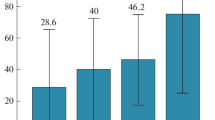Abstract
A retrospective analysis of medical records of 39 former male athletes with cardiovascular complaints (mean age 61.6 ± 11.3 years, mean duration of career in sports 23.9 ± 17.3 years, mean duration of the postathletic period 20.1 ± 9.9 years) was carried out in order to analyze the relationship between the athletic qualifications and cardiac arrhythmias and conductivity disorders in former athletes. The patients were screened for cardiac arrhythmias and conductivity disorders and underwent echocardiography. The overall prevalence of sustained paroxysms of atrial fibrillation was 42%; it increased with athletic qualifications. Ryan’s grade 4b–5 premature ventricular contractions were found in 14% of patients. Three parameters were found to be independent predictors of arrhythmias in former athletes: athletic qualifications, multifocal atherosclerosis (as an antirisk factor), and age. The coefficient of determination for the created prognostic model reached 43%. An algorithm was proposed to screen for rhythm disorders in former athletes based on clinical data. Further prospective studies are needed to validate the algorithm.
Similar content being viewed by others
REFERENCES
Britov, A.N., Pozdnyakov, Yu.M., Volkova, E.G., et al., Cardiovascular disease prevention: national recommendations, Kardiovask. Ter. Prof., 2011, vol. 6, no. 10.
Zadvorev, S.F., Krysiuk, O.B., Obrezan, A.G., and Yakovlev, A.A., Effect of personal history of athletic activity on the clinical course of cardiovascular diseases in former athletes, Adv. Gerontol., 2019, vol. 9, no. 1, pp. 91–97.
Khodasevich, L.S., Chuprova, S.N., Abakumov, A.A., and Khechumyan, A.F., Sudden cardiac death in sports: risk factors, nosological characteristics, and prevention approaches, Sport. Med.: Nauka Prakt., 2016, no. 6, pp. 76–85.
Aagaard, P., Sharma, S., McNamara, D.A., et al., Arrhythmias and adaptations of the cardiac conduction system in former National Football League players, J. Am. Heart Assoc., 2019, vol. 8, no. 15, p. e010401.
Maron, B.J., Zipes, D.P., and Kovacs, R.J., Eligibility and disqualification recommendations for competitive athletes with cardiovascular abnormalities: preamble, principles, and general considerations. A scientific statement from the American Heart Association and American College of Cardiology, J. Am. Coll. Cardiol., 2015, vol. 66, no. 21, pp. 2343–2450.
Baldesberger, S., Bauersfeld, U., Candinas, R., et al., Sinus node disease and arrhythmias in the long-term follow-up of former professional cyclists, Eur. Heart J., 2008, vol. 29, pp. 71–78.
Bohm, P., Scharhag, J., Meyer, T., et al., Data from a nationwide registry on sports-related sudden cardiac deaths in Germany, Eur. J. Prev. Cardiol., 2016, vol. 23, no. 6, pp. 649–656.
Clarke, P.M., Walter, S.J., Hayen, A., et al., Survival of the fittest: retrospective cohort study of the longevity of Olympic medalists in the modern era, Br. J. Sports Med., 2015, vol. 49, no. 13, pp. 898–902.
Corrado, D., Basso, C., Schiavon, M., and Thiene, G., Screening for hypertrophic cardiomyopathy in young athletes, New Engl. J. Med., 1998, vol. 339, pp. 364–369.
Flannery, M.D., Kalman, J.M., Sanders, P., and La Gerche, A., State of the art review: atrial fibrillation in athletes, Heart Lung Circ., 2017, vol. 26, no. 9, pp. 983–989.
Lin, Y., Gajewski, A., and Poznańska, A., Examining mortality risk and rate of ageing among Polish Olympic athletes: a survival follow-up from 1924 to 2012, Br. Med. J. Open, 2016, vol. 6, no. 4, p. e010965.
Reiner, Z., Catapano, A.L., De Backer, G., et al., ESC/EAS Guidelines for the management of dyslipidaemias, Eur. Heart J., 2011, vol. 32, pp. 1769–1818.
Ryabkova, V.A., Shubik, Y.V., Erman, M.V., et al., Lethal immunoglobulins: autoantibodies and sudden cardiac death, Autoimmun. Rev., 2019, vol. 18, no. 4, pp. 415–425.
Sitges, M., Gutiérrez, J.A., Brugada, J., et al., Consensus for the prevention of sudden cardiac death in athletes, Apunts Med. l’Esport, 2013, vol. 48, no. 177, pp. 35–41.
Svedberg, N., Sundstrom, J., James, S., et al., Long-term incidence of atrial fibrillation and stroke among cross-country skiers: cohort study of endurance-trained male and female athletes, Circulation, 2019, vol. 140, no. 11, pp. 910–920.
Tahir, E., Starekova, J., Muellerleile, K., et al., Myocardial fibrosis in competitive triathletes detected by contrast-enhanced CMR correlates with exercise-induced hypertension and competition history, JACC: Cardiovasc. Imaging, 2018, vol. 11, no. 9, pp. 1260–1270. https://doi.org/10.1016/j.jcmg.2017.09.016
van Buuren, F., Mellwig, K.P., Faber, L., et al., The occurrence of atrial fibrillation in former top-level handball players above the age of 50, Acta Cardiol., 2012, vol. 67, no. 2, pp. 213–220.
Wilhelm, M., Roten, L., and Tanner, H., Atrial remodeling, autonomic tone, and lifetime training hours in non-elite athletes, Am. J. Cardiol., 2011, vol. 108, pp. 580–585.
ACKNOWLEDGMENTS
The authors are deeply grateful to the cardiologist, Cand. Sci. (Med.) K.N. Shorokhov and cardiologist O.A. Savelyeva for their participation in the preliminary selection of patients.
Author information
Authors and Affiliations
Corresponding author
Ethics declarations
Conflicts of interest. The authors declare that they have no conflict of interest.
Statement of compliance with standards of research involving humans as subjects. All procedures performed in studies involving human participants were in accordance with the ethical standards of the institutional and/or national research committee and with the 1964 Helsinki Declaration and its later amendments or comparable ethical standards. Informed consent was obtained from all individual participants involved in the study.
Additional information
Translated by K. Lazarev
Rights and permissions
About this article
Cite this article
Krysiuk, O.B., Obrezan, A.G., Zadvorev, S.F. et al. Possibilities in the Prediction of Cardiac Arrhythmias and Conductivity Disorders in Former Athletes. Adv Gerontol 10, 363–367 (2020). https://doi.org/10.1134/S2079057020040104
Received:
Revised:
Accepted:
Published:
Issue Date:
DOI: https://doi.org/10.1134/S2079057020040104



